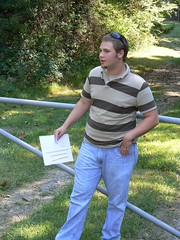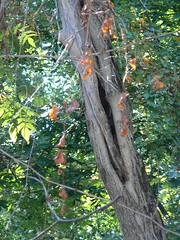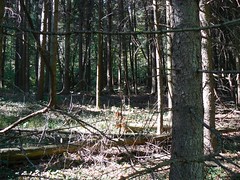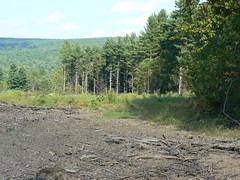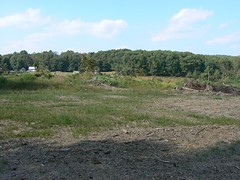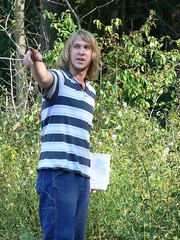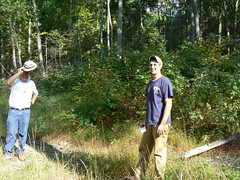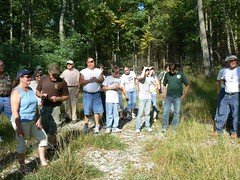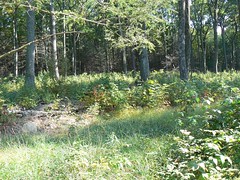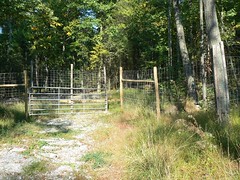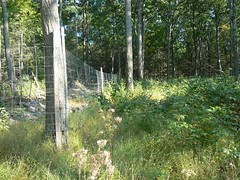Mont Alto forest technology students led a tour of forest management and silvical activities on the Waynesboro Watershed for members of the Cumberland County Woodland Owners Association and the Waynesboro High School Envirothon team yesterday afternoon (9/22) Below is a map of the sites visited:
View Larger Map
At the reservoir Dave Gillen discusses the purpose of the watershed, butternut canker, the importance of hickories for biological diversity and wildlife feed, and stand dynamics in an old norway spruce plantation.
Matt Reitzel described a 20+ acre clearcut to remove some stagnant softwood plantations, the problems with invasive plants, the use of herbicides, the re-establishment of american chestnut, and hybrid loblolly pine planting.
Adam Luther described a hardwood removal cut to release oaks. The twenty acre site was then fenced to keep deer. Today the oak stand is doing very well. The acorns were falling like rain.
The deer fence is essential.
Forest technology at Penn State Mont Alto and comments on forestry in general.
Sunday, September 23, 2007
Friday, September 14, 2007
Gypsy Moth Egg Masses
The gypsy moth infestation has been very heavy in south central Pennsylvania this summer. It looks like next year will be equally as bad, or worse. These pictures are from Oak Road in the Michaux State Forest in Quincy, PA. Most of the oaks on this hillside are just covered in egg masses!
Tuesday, September 11, 2007
Interpreting Airphotos in the Field
Yesterday, students in the Aerial Photo Interpretation class (FORT 230) visited selected sites on the aerial photos they are studying. Using the principles of interpretation: shape, shadow, pattern, association, texture, tone/color, and relative size, they compared the scene on the photo with what is actually on the ground today.
Given that the sets of photos we are using were taken in 1977, the element of time must also be included in the interpretation. Some areas have been harvested and others have grow in from previous harvests. Little of the area has changed through human use, however.
Here is a Google map of the sites the class visited:
View Larger Map
Digital pictures were taken at each stop and then geotagged with the location coordinates. Follow this link to see the geotagged images on a Yahoo Map in Flickr. Picasa albums also offers geotagging on a Google map as shown in this link. Each provider and format has its own advantages. There is probably a universal tool out there to combine these into one view.
Given that the sets of photos we are using were taken in 1977, the element of time must also be included in the interpretation. Some areas have been harvested and others have grow in from previous harvests. Little of the area has changed through human use, however.
Here is a Google map of the sites the class visited:
View Larger Map
Digital pictures were taken at each stop and then geotagged with the location coordinates. Follow this link to see the geotagged images on a Yahoo Map in Flickr. Picasa albums also offers geotagging on a Google map as shown in this link. Each provider and format has its own advantages. There is probably a universal tool out there to combine these into one view.
Monday, September 03, 2007
Oakworm Invasion in Boiling Springs, PA
This morning's Carlisle Sentinel has an article on a family's problems dealing with an outbreak of oakworms in their trees. They are understandably irritated with the falling caterpillar frass all over their yard. They are also worried that the defoliation would be be permanent, especially with the gypsy moth attacks, too.
The articles quotes experts from the Pennsylvania Bureau of Forestry and Cumberland Valley Tree Co. that oakworm attacks tend to be very localized. There is usually no need to spray, although homeowners can if they wish.
Forest pest stories seldom make the news unless there is something catastrophic going on. Few people know the war for existence going in the forest ecosystems just a few feet from their doors.
The articles quotes experts from the Pennsylvania Bureau of Forestry and Cumberland Valley Tree Co. that oakworm attacks tend to be very localized. There is usually no need to spray, although homeowners can if they wish.
Forest pest stories seldom make the news unless there is something catastrophic going on. Few people know the war for existence going in the forest ecosystems just a few feet from their doors.
Subscribe to:
Posts (Atom)
